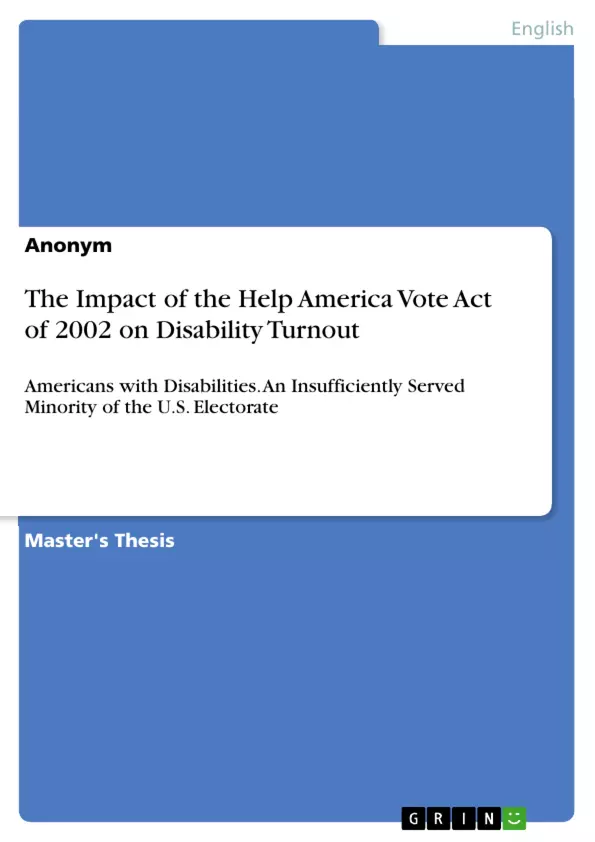The thesis explores the impact of the Help America Vote Act (HAVA) of 2002 on the voting participation of people with disabilities in the United States. It argues that HAVA has significantly improved accessibility at polling stations through specific provisions, particularly Section 301, which mandates accessible voting systems. These systems have enabled individuals with disabilities to vote independently and privately, thus addressing a primary form of discrimination at polling stations. The research heavily draws on data and analyses by Professor Lisa A. Schur and colleagues, and uses the policy cycle framework to assess HAVA's effectiveness in increasing voter turnout among this demographic.
Three amendments of the U.S. Constitution1 regulate the right to vote for American citizens. The 15th Amendment, which was ratified on February 3, 1870, prohibits disenfranchisement “on account of race, color, or previous condition of servitude” (Amendment XV, U.S. Constitution). On August 18, 1920, the ratification of the 19th Amendment extended the right to vote to all female citizens of the United States and barred any discrimination of the right to vote on the basis of sex. Almost two centuries after the U.S. Constitution had come into force in 1789, the 26th Amendment was ratified on July 1, 1971 guaranteeing the right to vote to every American citizen over the age of 18. Denial of this right on the basis of age is prohibited. Summarizing these legal provisions laid out in the supreme law of the United States of America, it is, therefore, not within the legal framework to prohibit the right to vote on the basis of race, color, social standard, sex or age. Universal suffrage is believed to have enabled all American citizens to be able to exercise their right to vote.
Inhaltsverzeichnis (Table of Contents)
- Introduction
- Methodology
- The Help America Vote Act
- Hypothesis 1: HAVA has made polling stations at federal elections more accessible
- Hypothesis 2: Stricter accessibility policies of electoral processes result in a decreasing disability gap of voter turnout
- Discussion of results
- Mobility and turnout
- Legal improvements for people with disabilities under HAVA
- The shortcomings of HAVA
- Convenience voting methods as alternatives to accessibility standards
- The impact of HAVA on disability turnout
- Conclusion
Zielsetzung und Themenschwerpunkte (Objectives and Key Themes)
This paper examines the impact of the Help America Vote Act (HAVA) on voter turnout of Americans with disabilities in U.S. presidential elections since 2002. It investigates whether HAVA has successfully addressed the challenges faced by people with disabilities in accessing and participating in the electoral process.
- The impact of the Help America Vote Act (HAVA) on voter turnout of Americans with disabilities
- The accessibility of polling stations and electoral processes for people with disabilities
- The role of convenience voting methods in improving voter turnout among people with disabilities
- The persistent disability gap in voter turnout and its potential contributing factors
- The effectiveness of legal frameworks in promoting inclusive voting practices for people with disabilities
Zusammenfassung der Kapitel (Chapter Summaries)
- Introduction: This chapter establishes the context of the study by highlighting the legal frameworks surrounding voting rights in the U.S. and the persistent disability gap in voter turnout. It introduces the Help America Vote Act (HAVA) as a potential solution to address these challenges.
- Methodology: This chapter outlines the research methods employed in the study, including the data sources, research design, and analysis techniques used to assess the impact of HAVA.
- The Help America Vote Act: This chapter provides a comprehensive overview of the Help America Vote Act (HAVA), its legislative background, and its key provisions related to accessibility and voter participation for people with disabilities.
- Hypothesis 1: HAVA has made polling stations at federal elections more accessible: This chapter examines the first hypothesis, investigating whether HAVA has effectively improved the accessibility of polling stations for people with disabilities.
- Hypothesis 2: Stricter accessibility policies of electoral processes result in a decreasing disability gap of voter turnout: This chapter delves into the second hypothesis, exploring the relationship between stricter accessibility policies and the reduction of the disability gap in voter turnout.
- Discussion of results: This chapter presents and analyzes the findings of the study, discussing the impact of HAVA on various aspects of voter participation for people with disabilities.
- Mobility and turnout: This chapter focuses on the relationship between mobility and voter turnout among people with disabilities, exploring the impact of accessibility improvements on their participation.
- Legal improvements for people with disabilities under HAVA: This chapter examines the legal improvements implemented by HAVA to enhance accessibility and voting rights for people with disabilities.
- The shortcomings of HAVA: This chapter discusses the limitations and shortcomings of HAVA in addressing the challenges faced by people with disabilities in participating in elections.
- Convenience voting methods as alternatives to accessibility standards: This chapter explores the role of alternative voting methods, such as absentee voting, as a means of enhancing voter participation for people with disabilities.
- The impact of HAVA on disability turnout: This chapter synthesizes the findings of the study, summarizing the overall impact of HAVA on voter turnout among people with disabilities.
Schlüsselwörter (Keywords)
This study focuses on voter turnout, disability, accessibility, the Help America Vote Act (HAVA), electoral participation, election administration, convenience voting methods, and the disability gap.
- Quote paper
- Anonym (Author), 2017, The Impact of the Help America Vote Act of 2002 on Disability Turnout, Munich, GRIN Verlag, https://www.grin.com/document/1477949



